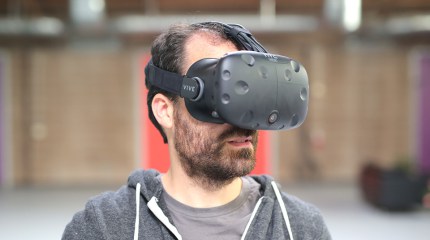Virtual reality headsets became a thing in 2016, with every big tech company — from Facebook to Google to HTC — committing big bucks to headsets like the Occulus Rift, Daydream, and Vive. But even with all that investment, the VR market is still essentially an extension of the PC video game market. For VR to make the leap from recreational gadget to transformational technology, we’ll need to, well, need it.
Here are four market segments where VR could gain a momentous foothold.
Helping busy people stay healthy
Between family and work obligations, many Americans can’t spare several hours a week to spend at the gym. Cyclists and other outdoor exercise enthusiasts face similar constraints, not to mention inclement weather and long travel times to good riding and rowing spots.
But what if we could get a workout that was both physically taxing and psychologically satisfying without ever leaving home? A workout that brought the best of the outdoors into our living rooms, while giving us the impression that we were some place thrilling? Indoor cycling company Zwift has demonstrated that people will do more indoors if you give them something to look at and a sense that they’re not just spinning their wheels, while Coreyak, a VR kayaking program that runs on multiple VR headsets, has raised thousands on Indiegogo since launching earlier this month.
Training better doctors
Medical students in the United States get their first hands-on experience not with living patients, but dead ones. Yet even though the cadaver lab is considered an essential training technique, the global expansion of the healthcare field has created scarcity in the cadaver market — which isn’t really a market at all, because schools can’t pay for the bodies. In response, some schools have introduced the use of virtual reality to familiarize students with human anatomy.
Medical experts aren’t convinced that VR will (or even should) fully replace cadaver labs, but that hasn’t stopped software developers from trying to match the cadaver experience with headset-ready anatomy programs. And proponents of VR medical training point out that the software allows for far more repetition and individual exploration than one-time use bodies that are often worked on by groups of five or more students.
Communing with nature
It might sound counterintuitive to suggest that plugging into a computer is the best way to experience natural beauty, but it can certainly make for an excellent supplement, as a group of London artists demonstrated this year. The Treehugger: Wawona exhibit allows visitors to go inside a sequoia tree, getting an intrinsically rare glimpse into how these ancient giants absorb and circulate nutrients. “By making the invisible visible” the exhibit’s creators hope to instill a sense of stewardship for rare and endangered forests.
Experiencing a world that would otherwise be out of reach
I might go to Mt. Everest in my lifetime. I might go to Antarctica. But unless I win the lottery, I doubt I’ll be able to afford both. Most people can think of dozens of things they’d like to do but can’t afford to. By importing far-away, high-dollar experiences to where we are, at a price we can afford, volumetric virtual reality — like the kind being developed by 8i — could offer a cure for the FOMO imposed by economic reality.





